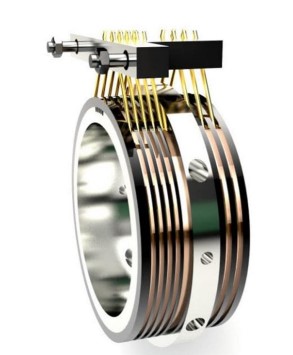
Understanding Slip Rings
A slip ring assembly is a device that transfers electrical power and/or signals from a stationary structure to a rotating one. The stationary structure, or stator, is usually fitted with a metallic contact brush assembly, and the rotating structure is fitted with metallic rings or discs. In operation, the rotating ring or disc assembly—the rotor— slides against the stationary contact brush assembly, maintaining electrical conductivity between them. In this way, electrical power and/or data are transmitted across the moving joint. Examples of common assemblies that include slip rings are steering wheels (for the horn and the steering wheel-mounted controls), joints in robotic arms, radar antennae, and scanning security cameras.
In this article, we’ll look at slip ring system applications, engineering challenges, material selection, and material testing.
Critical Applications
Slip rings are used in critical devices in many markets including aerospace, automotive, marine, medical, and industrial. Each application presents unique challenges in terms of operating conditions, speed requirements, and environmental exposure, from tough atmospheric conditions here on Earth to the vacuum of space.
Engineering Challenges
There are several challenges that must be addressed to develop a successful slip ring system. The two main performance characteristics that must be optimized are maintaining electrical conductivity between the brushes and rings; and meeting the lifetime durability requirements by managing the physical wear rates of the system, and the debris generated by the wear. If the components are not specified correctly, the system may generate increased electrical noise as the components degrade, or may suddenly fail.
Material Selection
This combination of demands makes material selection critical. While precious metals such as gold provide great conductivity and resistance to tarnish, they are usually too soft to be used in their pure form. DNI solved this problem by developing engineered alloys that combine the tarnish resistance of precious metals with the strength of non-precious structural materials, like copper and nickel alloys. Examples of DNI alloys most used in slip ring systems are Neyoro G, Ney 75, and Paliney 7.
Material Testing
There are many precious metal alloys available for slip ring design consideration. DNI runs a slip ring test program to understand how various ring-brush material systems perform under different conditions. This allows our team to guide engineers in material selection by using data from tests run under conditions that most closely match those expected in the application.
The testing process investigates the following:
- Electrical noise at different loads and speeds
- Wear characteristics evaluated by scanning electron microscopy and optical interference profilometry
- Environmental effects such as temperature and humidity
The testing and data interpretation reduces some of the trial-and-error in slip ring design. Engineers start with material combinations that have proven themselves in conditions similar to those expected in the application.
The advantages of this data-driven are:
- Reduced development time and cost
- Higher confidence in design decisions
- Better understanding of potential failure modes
While some iteration may be necessary, starting with tested material combinations significantly streamlines the development process.
Conclusion
Our test program helps us understanding how different materials systems perform under various conditions. As a result, we help engineers make informed material selections. We follow this up by manufacturing components made from our in-house precious metal alloys. This results in better-performing, more reliable slip ring systems that meet performance and durability requirements of these demanding applications.
Need assistance selecting the optimal material for your slip rings? Reach out to us today – we’re happy to help!
